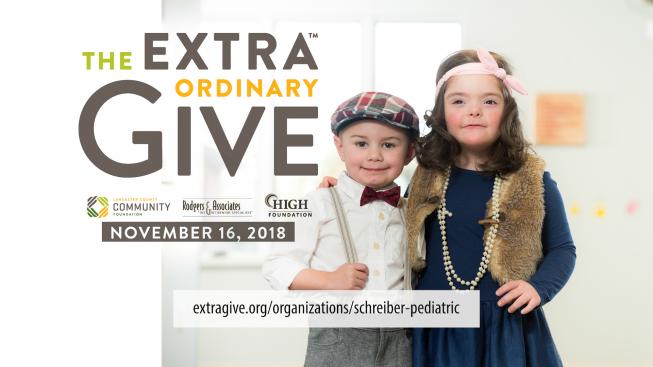Speech therapy
The Challenges Of Being Deaf In A Hearing School
September 20, 2023School can be a difficult space for any child to navigate, but when you add the additional challenge of being deaf, the difficulties only grow. By shining a light on the unique challenges that children who are deaf encounter in school we hope to help minimize them.
The Communication Barrier: A Key Obstacle
One of the most significant challenge that Deaf children face in school is the communication barrier. This barrier extends beyond the classroom, affecting interactions with both peers and teachers. Deaf children often encounter difficulties in fully understanding and engaging with lessons due to limited access to auditory information. This, in turn, can lead to academic delays, as their access to information is restricted.
Furthermore, a lack of awareness and training among teachers about the specific needs of deaf children can increase these challenges. Without proper training, educators might struggle to adapt their teaching methods to accommodate different learning styles and communication preferences. The result is that the potential of deaf students may go unrecognized and underdeveloped.
Social Isolation and the Emotional Impact
Education is not just about gaining knowledge; it also shapes a person’s social development. For children who are deaf, this can be a double-edged sword. Limited communication opportunities can isolate them from their hearing peers, making it difficult to form friendships and engage in extracurricular activities, clubs, and sports. A traditional classroom settings might not provide the necessary environment for effective communication, which can lead to a sense of isolation.
The consequences of such isolation are significant. Deaf children may face bullying and teasing due to their differences, which can lead to emotional distress and lower self-esteem. The lack of social interaction can hinder their emotional well-being and overall growth.
Access to Support Services and Inclusive Education
Access to appropriate support services is necessary to help mitigate these challenges. Sign language interpreters and note-takers help ensure effective communication and learning for deaf students. However, these services are not always available or properly implemented in educational institutions.
Inclusive education, which ensures all students receive equitable opportunities for learning and participation, is a cornerstone for breaking down barriers. Creating an environment that fosters inclusivity goes beyond just providing services—it entails changing attitudes and practices, and embracing the unique perspectives and strengths that each student brings.
The Power of Sign Language
A key solution to bridging the communication gap lies in the widespread adoption of American Sign Language (ASL). ASL is not just a language; it’s a pathway to breaking down communication barriers and fostering understanding between deaf and hearing individuals. By promoting ASL as a fundamental skill, we can lay the groundwork for a more inclusive and supportive educational experience for deaf children.
Building an Inclusive Future
In celebration of the International Week of the Deaf, it’s crucial to remember that the challenges faced by deaf children in school are not insurmountable. Through appropriate accommodations, specialized support services, comprehensive teacher training, and the promotion of sign language, we can create an environment where all children, regardless of their hearing ability, have equal access to quality education and social integration.
If you child is Deaf and you are interested in learning more about how Schreiber’s Pediatric Therapies can help your child visit: http://www.schreiberpediatric.org/therapy-services/
As a nationally recognized pediatric facility, the Schreiber Center for Pediatric Development provides family-centered education and therapy programs for infants, children and adolescents with disabilities, developmental delays, and acquired injuries. Our goal-oriented approach maximizes each child’s ability to function independently within the community.
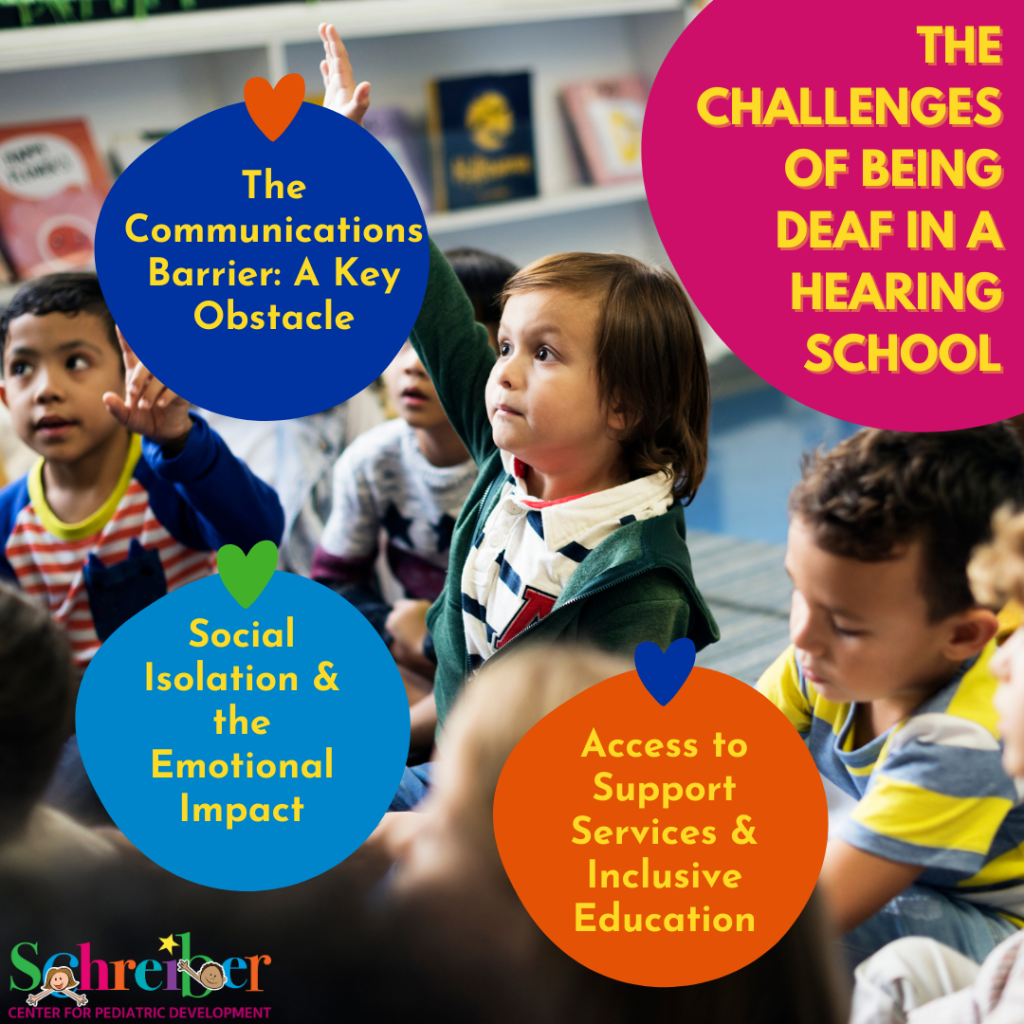
12 Communication Milestones to Look for in Deaf Children
September 19, 2023When it comes to the developmental journey of babies and children who are deaf, American Sign Language (ASL) communication milestones play an important role. Knowing what unique milestones to look for in babies, toddlers, and children who are deaf, allows caregivers to better understand the progression of communication skills. This article outlines 12 communication milestones caregivers of deaf children should look for to help guide their children on their unique communication journey through ASL.
Birth-6 Months: Building the Visual Foundation
1. Visual Tracking: From birth to six months, babies who are deaf begin to visually track moving objects and people. This foundational skill paves the way for their engagement in sign language communication.
2. Eye Contact: Establishing eye contact with caregivers and responding to visual cues is crucial for effective communication in ASL. Babies who are deaf develop this ability, enabling meaningful interactions.
3. Attention to Visual Stimuli: Infants who are deaf often display heightened attentiveness to colorful objects and gestures. This is because they rely on their sense of sight for communication input.
6-9 Months: Early Gestures and Interaction
4. Early Communication Gestures: Deaf babies might initiate simple gestures like waving “bye-bye” or raising their arms to be picked up. They could also display signs of wanting more, pointing at objects, or imitating gestures.
5. Initiating and Responding to Gestures: Babies who are deaf begin building the foundation for back-and-forth communication by both initiating their gestures to express needs or interests and responding to gestures from caregivers.
8-12 Months: Transition to First Signs
6. First Signs: The transition from gestures to recognizable signs like “milk,” “eat,” or “mom” starts around 8-12 months old. These initial signs become the building blocks for more intricate communication.
7. Understanding and Following Directions: Deaf babies gradually grasp the ability to comprehend and follow simple sign language directions like “come here” or “give me.”
12-36 Months: Forming Complex Communication
8. Combining Signs: Toddlers who are deaf begin combining signs to form two-word phrases between 1 and 3 years old. This progression allows them to express more complex thoughts and desires.
9. Expressing Preferences and Desires: As toddlers learn more ASL, they use signs to voice preferences, wants, and dislikes. This allows them to increase their ability to actively engage in conversations.
10. Narrative Skills: As they progress and broaden their signing vocabulary children who are deaf are able to convey simple stories and describe events using ASL, nurturing their narrative skills.
3+ Years: Maturing Communication Abilities
11. Understanding and Using Complex Syntax: As children who are deaf grow, their ASL skills evolve to include more complex sentence structures and grammatical features, enhancing their overall communication abilities.
12. Participating in Group Conversations: Proficiency in group conversations, topic tracking, and turn-taking is a significant milestone for children who are deaf using ASL. This skill underscores their ability to engage actively in social settings.
Remember that every child follows their own developmental path. Early exposure to ASL, consistent interaction, and access to a supportive environment are all important to helping babies, toddlers, and children who are deaf develop ASL skills. Celebrating these communication milestones helps to foster a culture of inclusivity, understanding, and effective communication for all.
If you child is Deaf and you are interested in learning more about how Schreiber’s Pediatric Therapies can help your child visit: http://www.schreiberpediatric.org/therapy-services/
As a nationally recognized pediatric facility, the Schreiber Center for Pediatric Development provides family-centered education and therapy programs for infants, children and adolescents with disabilities, developmental delays, and acquired injuries. Our goal-oriented approach maximizes each child’s ability to function independently within the community.
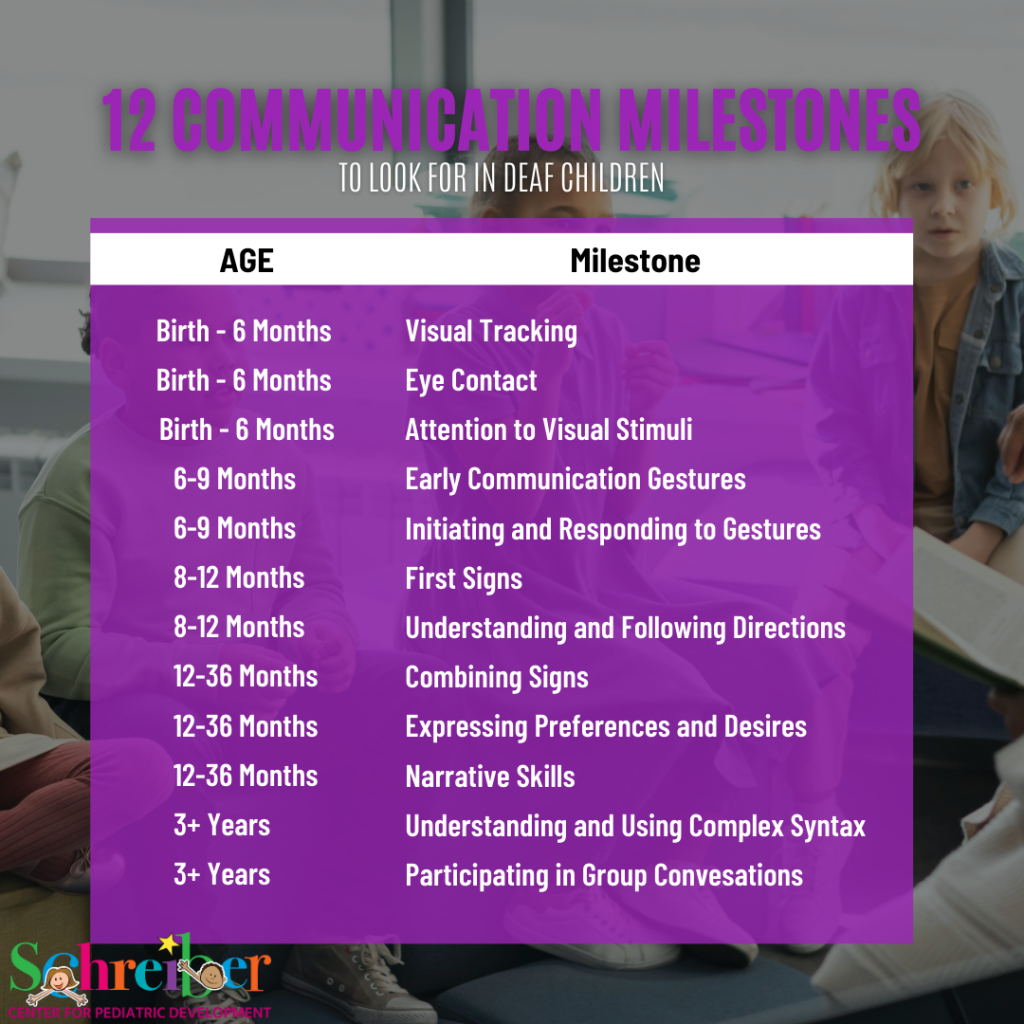
How to Communicate with the Deaf Community
September 18, 2023In a world that strives for diversity and inclusivity, it’s essential to recognize and celebrate different cultures and communities. Today marks the beginning of the International Week of the Deaf, a time dedicated to fostering understanding and connection with the Deaf community. This presents a wonderful opportunity to delve into the realm of inclusivity and explore some invaluable tips for engaging meaningfully with people who are Deaf.
Discovering the World of Sign Language
Taking the time to learn a few basic American Sign Language (ASL) signs and gestures is one of the most meaningful steps you can take to embrace inclusivity and engage with the Deaf community. You may think that learning an entirely new language sounds daunting, but taking the time to master even a few fundamental signs can go a long way in bridging the communication gap between the hearing and the Deaf.
Eye Contact, Facial Expressions, and Personal Space
Maintaining consistent eye contact when communicating with anyone is respectful, but especially important in conversations with people who are Deaf. When Deaf people talk to each other they are most often maintaining eye contact. While a hearing person may only see hands forming ASL signs, when it comes to communicating using ASL facial expressions convey tone, emotion, and context. Because facial expressions play a crucial role in sign language, it is important to make sure that when you are communicating with a person who is Deaf your face is well lit and able to be seen easily. As a visual language ASL also requires additional personal space, and maintaining that space shows both consideration and respect, promoting a welcoming atmosphere that encourages open communication.
When to Write it Out & Use Visual Aids
If you find yourself in a situation where complex information needs to be shared, and you are not fluent in ASL, it can be useful to use a pen and paper, or electronic notes device to communicate instead. Using visual aids is a great way to enhance communication with a person, or people, who are deaf, especially in group settings. Utilizing tools like presentations or written materials ensures that everyone in the group is on the same page.
Eliminating the barriers of misunderstanding and allowing for accurate exchange of information is important but remember that while this approach is practical and ensures seamless information sharing it can be alienating as it removes human emotion from the conversation. Learning basic ASL and using it before resorting to writing out your message can help maintain connection during the conversation.
Commit to Inclusivity Everyday
By taking steps to learn and use basic American Sign Language (ASL) signs, respecting the significance of eye contact, facial expressions, and personal space, and incorporating written communication and visual aids when needed, we can dismantle communication barriers between the hearing and Deaf communities. When we commit to inclusivity everyday, we can create meaningful interactions and change the world for the better. We challenge you to take these tips to heart and share them with your family and friends.
If you child is Deaf and you are interested in learning more about how Schreiber’s Pediatric Therapies can help your child visit: http://www.schreiberpediatric.org/therapy-services/
As a nationally recognized pediatric facility, the Schreiber Center for Pediatric Development provides family-centered education and therapy programs for infants, children and adolescents with disabilities, developmental delays, and acquired injuries. Our goal-oriented approach maximizes each child’s ability to function independently within the community.

Carter Peiffer: Back from the brink
March 17, 2022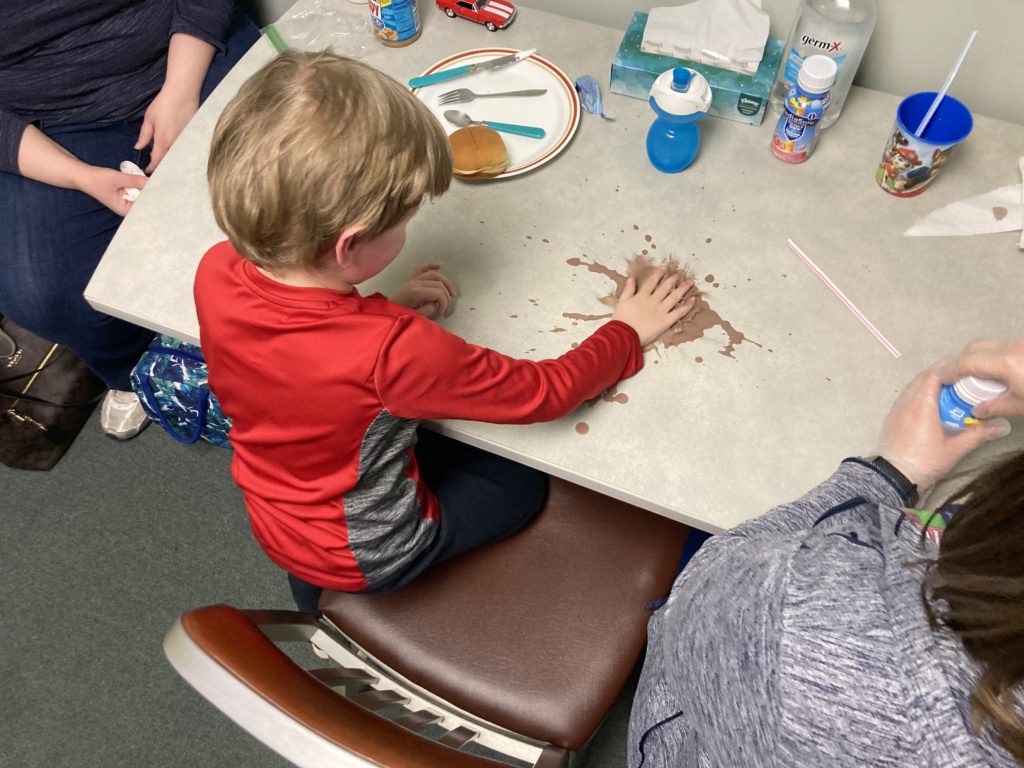
For Carter Peiffer, an occupational therapy session with Sarah Terry will usually involve food. And making a mess with food.
The mess is by design. A puddle of PediaSure on the table is fair game for Carter to write his name in, drive a toy car through or give a sip to Elmo. He might pull a straw from a cup filled with the nutrition drink and sniff (good) or take a tiny taste (better) from the end of the straw.
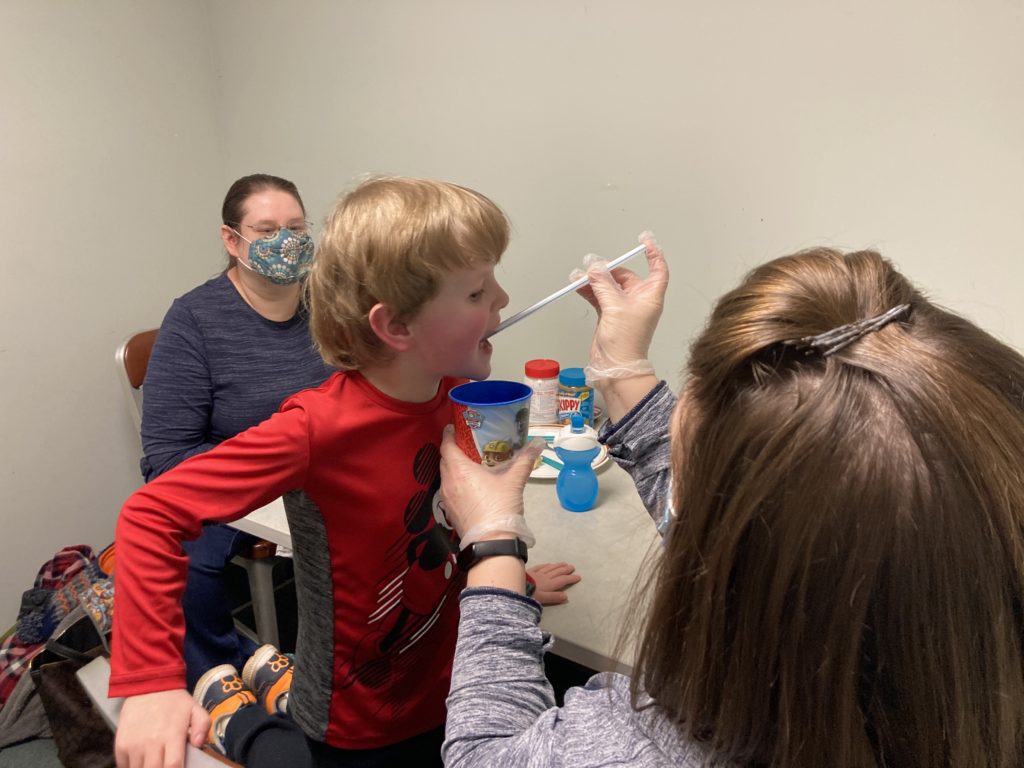
It’s all about making food fun for Carter, giving him positive experiences. He and food have had a rough two years. Through a series of life events, Carter went from a happy, active 2 year-old who would eat lots of different foods to a 4 year-old who would only eat strawberry banana yogurt — and it had to be Gerber’s. The lack of variety and nutrition in his diet over time left him with a severe vitamin C deficiency and a case of what used to be called scurvy. That caused his bones and muscles to weaken, to the point where his bones became brittle and he couldn’t walk or even stand without help.

Let’s go back to the beginning. When he was 2, his mother Desiree said she noticed Carter was a little delayed in speech. But he was otherwise active and healthy. Then he gradually began to cut out some foods, starting when Carter’s brother was born. Around the same time, his grandmother was in the hospital for an extended period following heart surgery.
These new stresses in his life caused him to become even more picky with his eating, to the point where all he would eat was the yogurt.
In March a year ago, Carter was running around playing when he tripped and fell. He ended up breaking the growth plate in his left knee, which required a knee immobilizer. A month later, he fell again — still wearing the immobilizer on his right knee — and broke the growth plate in his other knee.
After another round of medical visits, doctors at Children’s Hospital of Philadelphia in May found multiple tiny fractures in his bones and sent him to CHOP’s emergency department for an immediate, intensive examination.
Their conclusion: Carter’s increasingly limited diet for more than a year had caused a dangerous vitamin C deficiency that had weakened his bones and left him susceptible to fractures. His overall medical state was as fragile as his little brittle bones.
He spent nine days at CHOP in May receiving treatment and starting inpatient therapy. Later that month, after he was sent home, Desiree called Jen Bachman, our social services director, to arrange starting services at Schreiber.
In early June, Carter had his first physical therapy visit. After not being able to put any weight on his legs because of his knee injuries, step one in his recovery was relearning how to walk. He did aquatic therapy in our therapy pool with Megan Campbell Roland, and PT in the gym with Laurie Panther.
Desiree said Laurie noticed some sensory issues and suggested Carter be evaluated for occupational therapy. In September, doctors diagnosed him with autism and sensory processing disorder, and he started working with Sarah for OT. The work there has focused on helping him expand the variety of foods he ate.
“Carter, what did you eat today?”
Sarah asked the question at the start of a recent therapy session.
“Some peanut butter bread, and I ate some hot dog!”
“You did not,” Mom said. She smiled and gave him a what-are-you-talking-about look. “You had some yogurt.”
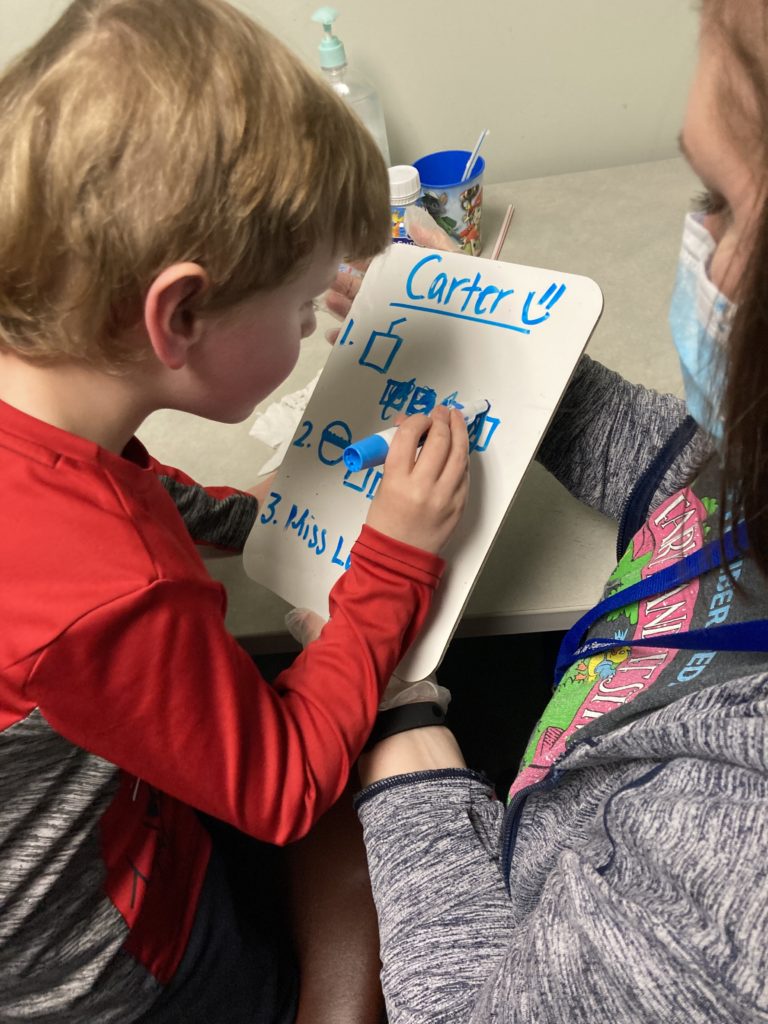
“Yogurt,” Carter repeated back, and then swirled some PediaSure around the table with his fingers.
Sarah had a dry erase board next to her with Carter’s eating goals for the session written in blue marker. When Carter accomplished one of his tasks for the session, Sarah had him fill in the box next to that task on the white board.
The work with Sarah on eating is paying off. Desiree said Carter weighed 29 pounds when he arrived at CHOP a year ago and 32 pounds when he left. Today, his weight consistently ranges between 42 and 45 pounds.
“Sarah got him to eat peanut butter and marshmallow (sandwiches),” she said. “He started eating chips. He tried an animal cracker and a pretzel. He seems to like the crunchy stuff.”
It’s a constant process, sometimes painfully slow, sometimes with setbacks.
“When he gets derailed, when he gets sick, he shuts down (and stops eating),” she said. “I’ve had to stay up all night with him to give him water, because getting dehydrated would mean we’d have to go to the ER.”
The progress is obvious, and not just with his eating.
“He’s able to walk and run and is almost back to where he was before all this started,” Desiree said. “He plays on the playground. He goes up and down steps. He’s able to express himself more now.”
Later, she talked with a lot of emotion about what she has seen bringing him to every appointment for the past nine months.
“To see his progress has been amazing. I know (coming to Schreiber) will all end at some point, but everybody has been so amazing. They are like family here, and Carter loves being here.”
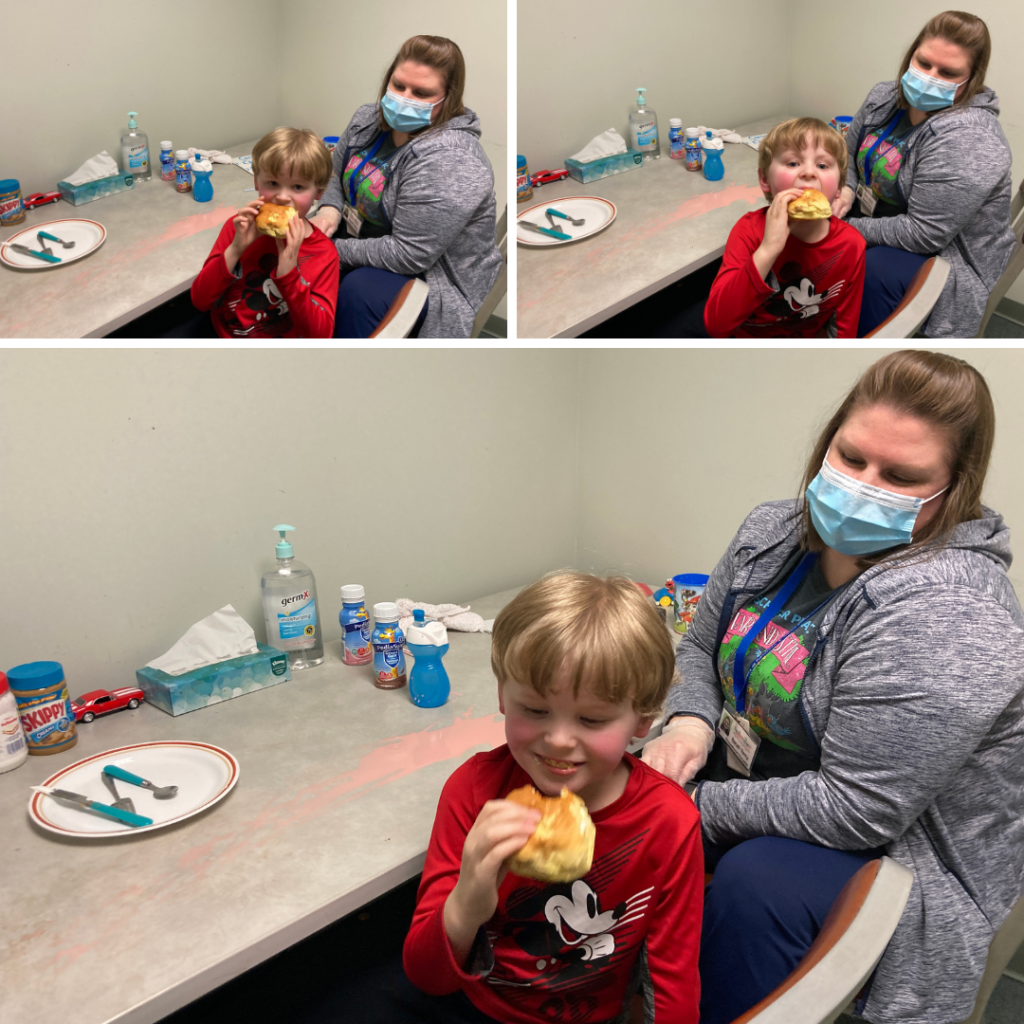
After taking two tentative tastes of a strawberry nutrition drink, Carter finishes the session with a reward: a bite of his peanut butter sandwich.
For the Kiss family, dedication mixed with gratitude
March 4, 2022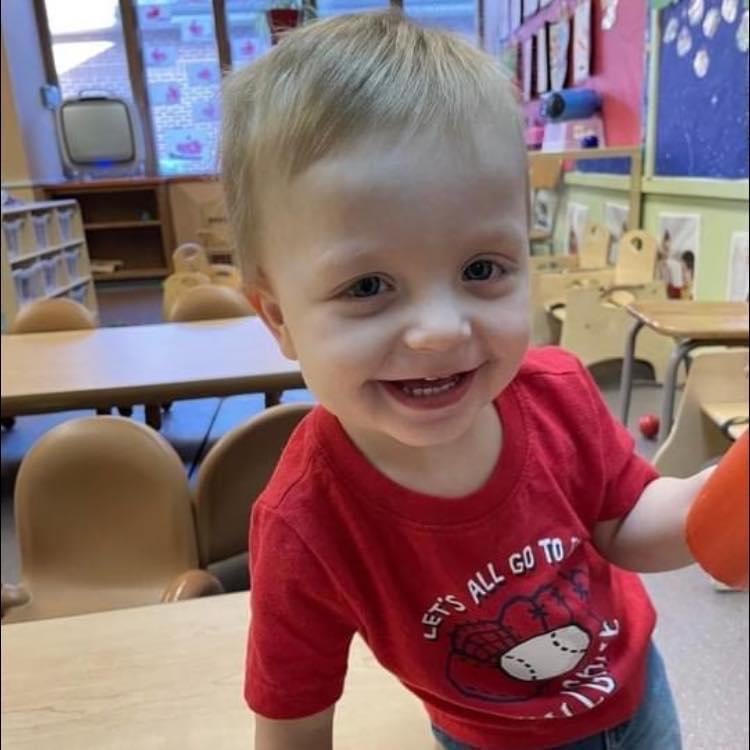
The complications for Colton Kiss started the moment he was born. His mom, Tara Kiss, said doctors used vacuum extraction to help with delivery.
The procedure “caused four intracranial brain hemorrhages,” Tara wrote in an email, “as well as a blood clot on his cerebellum, which is the part of the brain that controls movement, balance and speech.”
Colton was quickly transferred from Lancaster to Children’s Hospital of Philadelphia, widely known as CHOP, where he spent the next two weeks in the neonatal intensive care unit (NICU). Tara, living in York at the time, stayed with her mother, Cathy Kiss. Cathy lives in Manor Township, and Tara drove back and forth to Philadelphia every day for those two weeks to be with Colton.
When Colton was 4 months old, a follow-up MRI showed the blood clot and hemorrhages were gone, but the clot left behind an area of damage on the cerebellum.
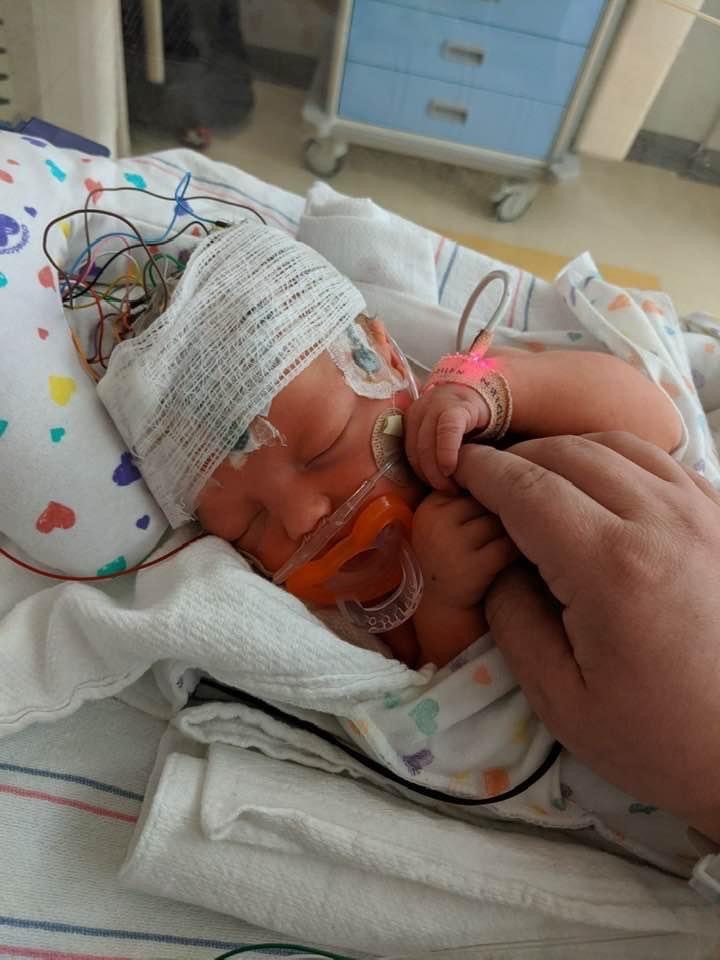
“We learned from his neurologist that we were looking at a long road of obstacles as that part of the brain is so important to everyday life — walking, talking, motor skills…,” Tara wrote.
CHOP referred them to Early Intervention and outpatient pediatric therapy. After doing some research and talking with friends, Tara knew she wanted to start services with Schreiber. Cathy’s best friend’s father, Joe Finger, had volunteered here with a group of other residents from St. Anne’s Retirement Community. Cathy also knew Michele DeBord, sister of Schreiber President James DeBord.
“Hearing about (Joe’s) experience and knowing Michele was so passionate about Schreiber, we were really comfortable (starting at Schreiber),” Cathy said.
Colton was born in March of 2020. Tara moved to Lancaster in December of that year to start services at Schreiber.
“We were immediately welcome by the Schreiber staff who are now pretty much our family,” Tara wrote. “Lisa (Moore, at the front desk) took us in under her wing and connected me to Jen Bachman to get Colton evaluated and started right away. We have been working with Miss Christen (DeSarro) for PT, Miss Kim (Martin) for OT and Miss Cassie (Glick) for speech. When we started, Colton was unable to sit unassisted, unable to feed himself solid food, unable to say any words at all.”
That was where Colton was in early 2021. Today? He still receives all three therapies, and he’s enrolled in Schreiber’s Circle of Friends Academy child care program, in the Toddler Room.
“Whether children are born healthy or born with already known obstacles, every child deserves a chance to be helped, and Schreiber gives every child a fair chance at a normal life.”
Tara Kiss, Colton’s mother
“It has not even been a year yet,” Tara wrote, “and he is now able to sit, stand alone and take his own steps on flat surfaces. He can feed himself any type of food he desires. He is working on his words and attempting new words almost daily. We are only in the beginning of this journey, but because of the dedication from our Schreiber family, Colton has a chance to live his life as normal as possible.”
Which is why Cathy reached out just about a year ago at this time offering to help with our first Cup O’ Cards fundraiser. The idea for Cup O’ Cards was simple: We bought a bunch of gift cards from local businesses, stuffed them into some sponsored coffee cups, then raffled off the cups.
“I heard about it from Michele, I looked at your website, and I decided to jump right in” by donating a card-filled coffee cup, she said.
Cathy, who runs her own home-based accounting business, CLK Accounting and Payroll Inc., reached out to a number of clients and asked them to donate money to buy gift cards or to donate cards from their business. We quickly added her CLK Accounting mug to the other cups, and it turned out to be popular with raffle ticket buyers.
She was happy to participate in the second Cup O’ Cards raffle, which starts March 28, and she plans to do two cups this year, including a Mystery Cup filled with a collection of surprise gift cards.
“I’ve already raised more than $600 in cash, which I’ll use to buy the gift cards,” Cathy said, “and collected two donated items for the Mystery Cup.”
Last year, with Cathy’s help, Cup O’ Cards raised about $27,000. This year, with her help again, we hope to raise even more. And that would be make a proud grandmother pretty happy.
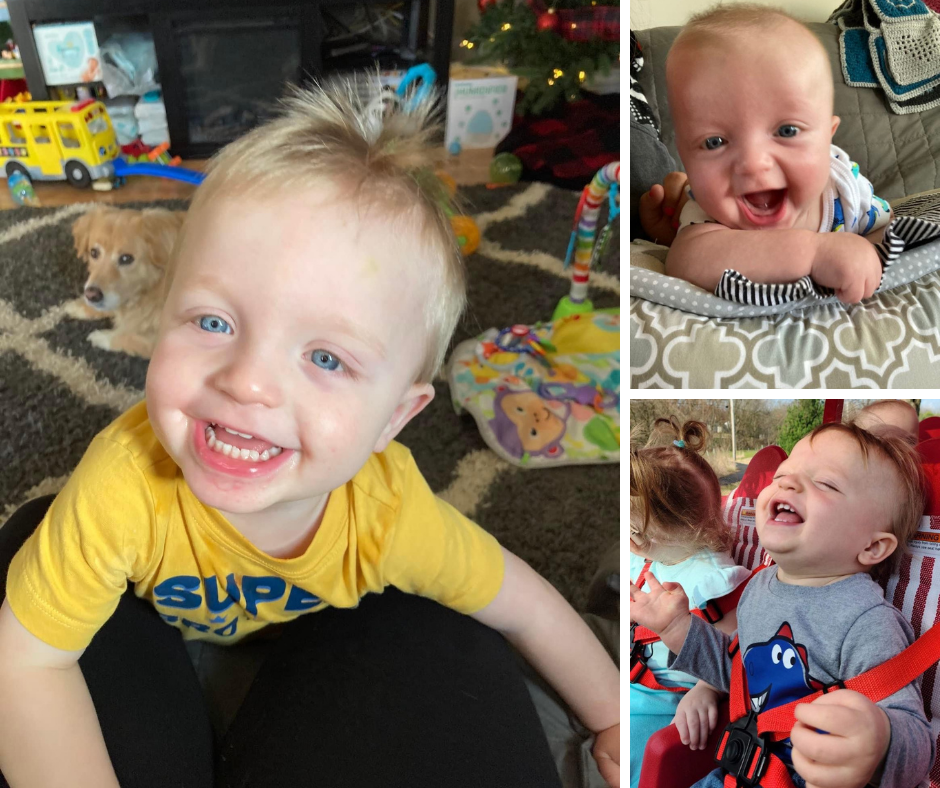
“That’s my boy,” she said. “And I see what Schreiber does for kids with my own eyes. (Colton) didn’t sit up until he was maybe 10 or 11 months old. He’s very delayed. To see his progress with the therapists is what I love about Schreiber.”
Tara said it this way in her email:
“… Whether children are born healthy or born with already known obstacles, every child deserves a chance to be helped, and Schreiber gives every child a fair chance at a normal life. That is something I will always support. We are forever grateful for Schreiber and the care my son receives. From his teachers at Circle of Friends Academy down to all of his therapists, thank you all for loving my son!”
Schreiber mom: From advocate for others to advocate for son
December 17, 2021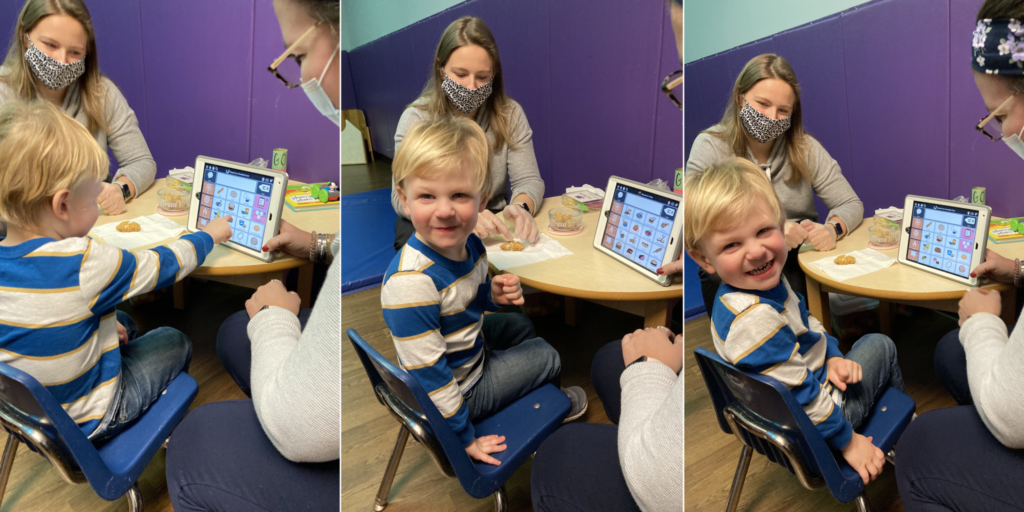
Amanda Katchur is a psychologist who has been an advocate for services that support children for a number of years. Now, she’s learning to advocate for her own child, and that’s a completely different experience.
It’s one thing to know professionally the impact that Schreiber’s services and Lancaster County’s Early Intervention program have on families. It’s another thing to see it personally.
Her daughter Bethany was diagnosed as an infant with torticollis, a condition in infants that causes a baby’s head to tilt constantly to one side. Thanks to the work of Schreiber therapists, Bethany’s torticollis is gone and she runs, jumps and dances just like any 6-year-old little girl, Amanda said.
Bethany’s little brother Leo, 3 years old, has an autism diagnosis, was born with mild hearing loss and also had some torticollis as an infant. The three issues combined have left him behind in several areas of development. When it was time for Leo to receive services through Early Intervention, at 6 months old, Amanda had no hesitation.
“I knew we wanted to come back (to Schreiber) because we had such a positive experience with Bethany,” Amanda said.
Leo has been in good hands his therapy services started. Catherine Donahue was his Schreiber’s Early Intervention specialist for home visits. Dorlas Riley was his speech-language pathologist. Denisha Roberts worked with him in physical therapy. And Bernie Hershey has been his occupational therapist.
I like to think that we’ve been fortunate to have, like, the dream team…, with all the experience they have with his issues.
AMANDA KATCHUR
“They were all really great,” Amanda said. “I like to think that we’ve been fortunate to have, like, the dream team to be quite honest with you, with all the experience they have with his issues.”
COVID has, at times, made the therapy more challenging, like when the family had to switch to telehealth services for a time. At those moments, she could see the lengths the Schreiber team would go to for a child.
When telehealth sessions switched back to in-person visits, the change and the lack of consistency caused some challenges for Leo, as it does for many kids on the autism spectrum.
“Bernie showed up at one point at our house in costume as Jessie from “Toy Story” to try to re-engage after telehealth with Leo a little bit,” Amanda said. “They just really always made an attempt (to find what) he was interested in and get into his world, which I appreciated so much.”
During a recent therapy session at Schreiber, Leo worked with Marli Hess, an intern in Occupational Therapy, and Maddy Sova, a speech-language pathologist. They were trying to help him become more comfortable with a different kind of food – in this case, a chicken nugget – and to improve his language skills by using a smart tablet to respond to questions.
“We are working on communication in whatever way Leo feels most comfortable,” Amanda said. “Today, you saw him working on some eating, because eating has been a struggle for us, too. So he’s been working on increasing his tolerance for different foods and different textures and things like that. But communication has been, I would say, the biggest one.”
Mom was impressed with the way Leo greeted a visitor to the session, smiling and waving. “He probably wouldn’t have done that six months ago,” she said.
EI services do make a difference
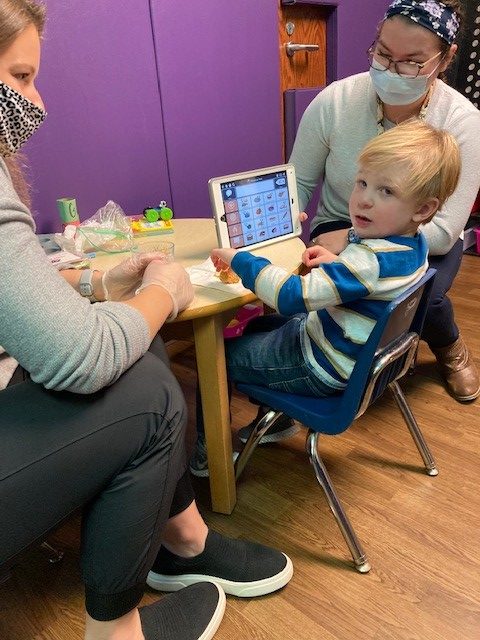
Mandy Kolb Lyons is a coordinator in Lancaster County’s Early Intervention services program. She sent this email to agencies that provide Early Intervention services after a recent presentation to the agencies by Amanda Katchur. Amanda presented at the PA Statewide Interagency Coordinating Council (SICC) meeting to share her family’s story and how Early Intervention supported them.
Here’s an excerpt from Mandy’s email:
“Amanda shared numerous examples of how you helped to coach, support, empower and guide her and her family. Amanda beamed as she shared the journey that her son and family had with Early Intervention and mentioned a few times how Early Intervention supported her entire family, including Leo’s big sister! Not only did Leo grow and progress throughout services, his entire family did. We can only hope that every family that participates in Early Intervention can walk away feeling similarly to how Amanda and her family did after participating in our services.”
Deanna and Zoey learn to live with Rett
May 20, 2021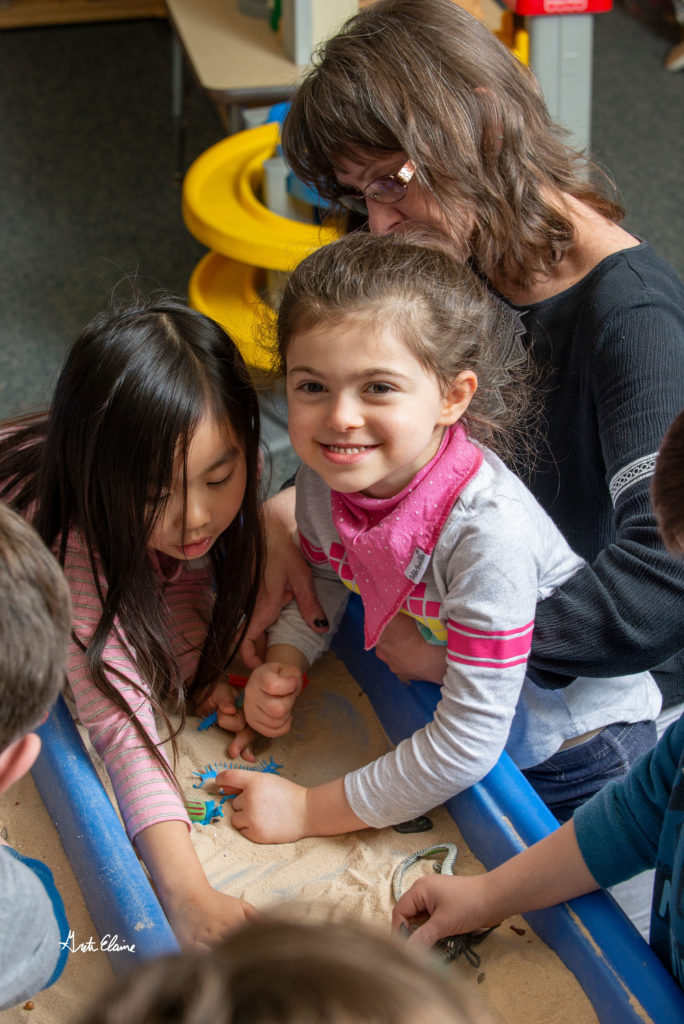
Zoey Adair
Zoey and some of her preschool friends play in a sandbox in a photo from 2019. Zoey has learned many different skills at Schreiber as she and her family deal with her diagnosis of Rett Syndrome, a rare genetic disorder.
Deanna Adair has been a Schreiber physical therapist for five years. Her daughter Zoey attended Schreiber’s S.T.A.R.S. preschool and Circle of Friends Academy and is now in kindergarten. Zoey also receives therapy services. She has Rett Syndrome, a rare neurological disorder affecting mostly girls. Individuals with Rett appear to develop normally until 6-18 months of age, after which they go through a regression and lose acquired skills. Zoey was diagnosed at 21 months of age. She began to display gross motor and language delays by 9-10 months of age, and began to lose her fine motor skills around 18 months.
Zoey, who will turn 7 in July, is unable to walk independently or talk, and has lost the ability to use her hands functionally or chew food. She communicates using an Eyegaze device and a yes/no board. She eats pureed foods and drinks thickened liquids, and has a feeding tube for supplemental hydration.
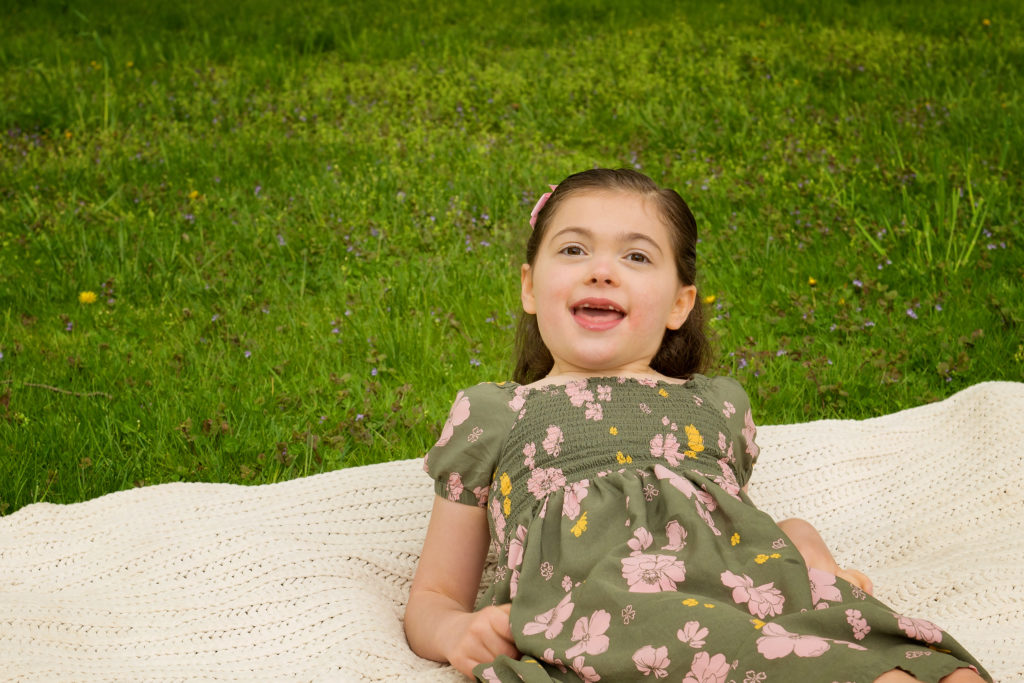
She also has scoliosis and obstructive sleep apnea, for which she uses a BIPAP machine. Rett Syndrome is not a degenerative disorder (brain cells are intact), and has been shown to be reversible in a lab setting, indicating that it may be curable in humans.
Deanna recently wrote a Facebook post to mark the fifth anniversary of Zoey’s diagnosis. She agreed to share it here.
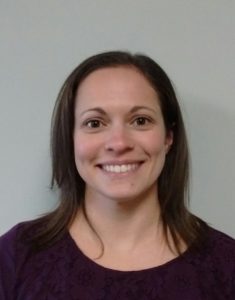
I can’t believe it’s been five years since we received Zoey’s Rett Syndrome diagnosis. It was Friday the 13th. I was on my way from my old job to pick her up from day care at Schreiber and answered the phone call as I was getting on the highway. I thought they were going to tell me that further testing was needed, because they only agreed to test for Rett “for peace of mind,” since I asked, but that’s not how it went. They gave us an appointment at the CHOP Rett clinic three days later and told me not to look it up on the internet. Guess what I spent the entire weekend doing?! After two days on the couch, I had to pick myself up and do what needed to be done for our girl. After all, she was the same sweet, beautiful little girl she had been before the diagnosis.
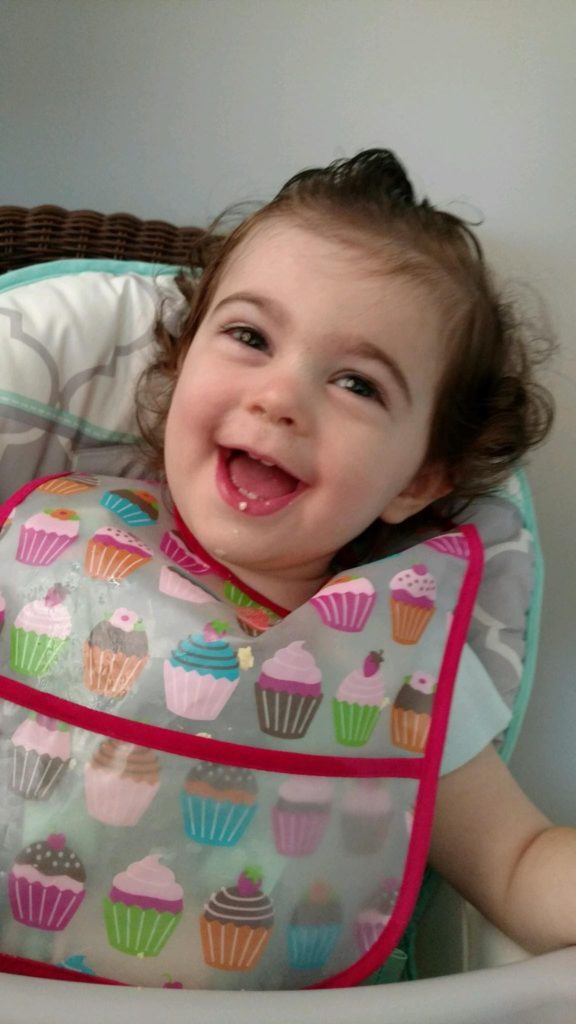
We have learned a lot since that day, and we are determined to give her the best life possible and find ways for her to learn and experience as much as she can. She is such a sweetheart, has a sense of humor, is smart, works hard, and is just a happy girl. Life has not been easy, and we have our tough times, but she is worth it!
Lately, we have been working on things like a special needs trust for her future, which can be overwhelming to think about, and the older she gets without there being a treatment or cure, the harder it is, too. But our girl has had an amazing year in kindergarten, having fun and learning to read and write using eye gaze, and we are so proud of her!
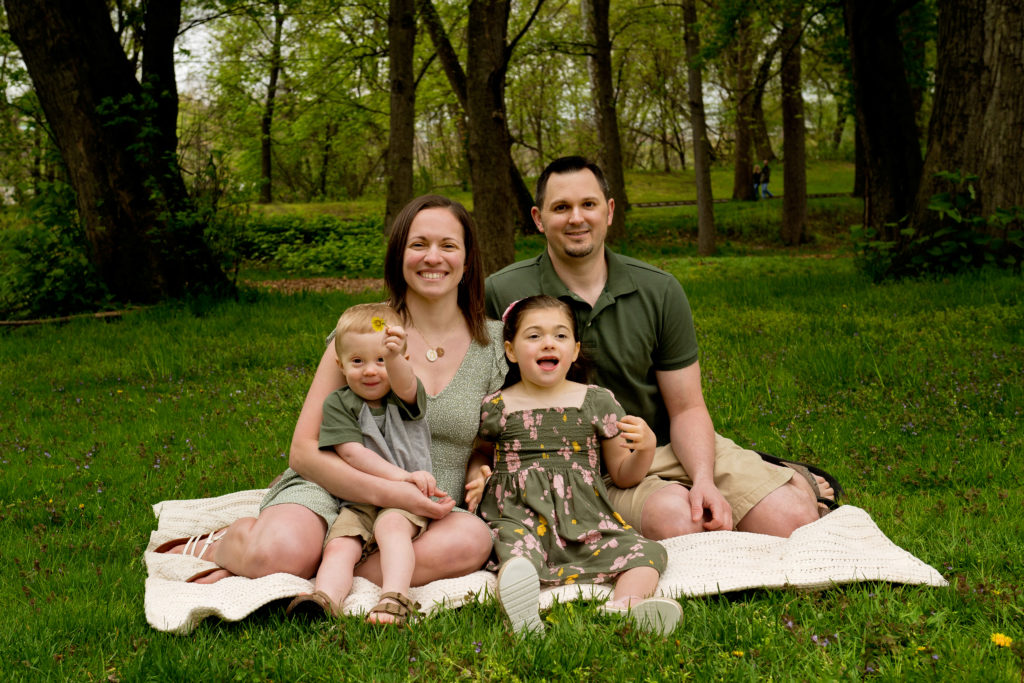
Penn State awards first Schreiber scholarship
May 11, 2021Anicia Anderson can trace her interest in a speech-language pathology career to hearing a guest speaker during a high school health class. She was in 10th grade at North Haven High School, a public high school in North Haven, Conn.
The speaker was looking for volunteers to come and work in a group home for older adults with autism. Anicia said she thought it sounded interesting, and she needed the community service hours, so she went.

“That was my first experience with people that were non-verbal,” said Anicia, thoughtful and gracious with her time during a recent phone interview. “That kind of geared my passion to wanting to work with people that have communication challenges.”
That first psychic nudge started her on a path toward a career she knew nothing about as a 15-year-old in the little town of North Haven (population about 25,000), a northern suburb of New Haven, home of Yale University.
Anicia received her bachelor’s degree from Penn State this spring and will begin pursuing a master’s degree there in speech-language pathology. She is the first recipient of the Schreiber Center for Pediatric Development Educational Equity Graduate Scholarship. The scholarship comes from a new fund established by Schreiber and Penn State to address the lack of diversity in the field of speech therapy.
“There’s not a lot of diversity in the field of speech-language pathology,” Anicia said. “Clinicians see clients from all different backgrounds and races and cultures. Inclusion is important: having a diverse clientele, having more diverse students entering the field, having more diversity among clinicians. I look forward to helping to make that change.”
Anicia didn’t know much about the scholarship or Schreiber before she was admitted into the grad program. “I’m in a diversity recruitment group, and I heard the name, but I didn’t really know what it was about.”
That soon changed. Dr. Diane Williams is a professor and department head in the Department of Communications Sciences and Disorders, where Anicia will continue her speech therapy studies. She approached Anicia about the scholarship.
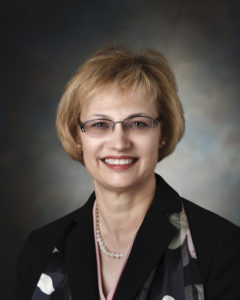
of the Department
of Communication Sciences
and Disorders at Penn State
“We chose Anicia because of her academic achievements,” Dr. Williams wrote in an email, “her strong letters of recommendation, her interest in working with children with complex communication needs like those served by the Schreiber Center, and because of her efforts around issues of diversity and inclusion.”
Dr. Williams joined a recent Schreiber board meeting to announce the first scholarship award. In her remarks, she thanked Schreiber’s leadership for its willingness to take a strong stand on increasing diversity, and for their good timing.
“When James (DeBord) reached out to us last year, the timing was just right,” Dr. Williams said. “My department had come together to make a commitment to work to increase diversity in the field of speech-language pathology. James’ offer to raise funds for a scholarship to support a student in speech-language pathology from a diverse background was such a generous one. We saw it as not only an opportunity to help us increase the diversity in our graduate program and our field but also as an opportunity to form a stronger relationship with the Schreiber Center, a program with an incredible history of service to the community.”

DeBord, Schreiber’s president, said he was excited to hear that Penn State had found such an outstanding student to be the first Schreiber scholarship recipient. And, he added, this is just the beginning.
“My hope is that Anicia is the first in a long line of scholars and future speech-language pathologists who will change countless lives for the better,” James said. “And that they will better reflect the communities in which they serve. The plan now is that this continues every two years, in perpetuity. She will be the first in this pantheon of these distinguished scholars.”
Anicia comes from a town where fewer than 5 percent of the population is black. She said she was one of the few black students at her high school.
Pursuing a career in speech therapy, in which around 95 percent of therapists are white, might seem intimidating for some students of color. Anicia was unfazed.
“Since I went to a school that didn’t have a lot of diversity, it’s something that I’m used to,” Anicia said. “Increasing diversity is important; it can help to open people’s minds.”
Donate to the scholarship fund
Schreiber has raised about half of the $275,000 needed to fulfill its pledge to create the $550,000 scholarship fund. To make a donation and help Schreiber continue the work of making the field of speech-language pathology more diverse, visit the Penn State Scholarship Fund page here.
Penn State students build a better bike for Schreiber
February 26, 2019We have a lot of therapy bikes at Schreiber. But there was a certain kind of bike we were missing: a hand bike, no pedaling, for school-age kids. Enter a group of senior mechanical engineering students from Penn State Harrisburg.
Bernie Hershey, a Schreiber occupational therapist, was the one who suggested the project to the group in September.
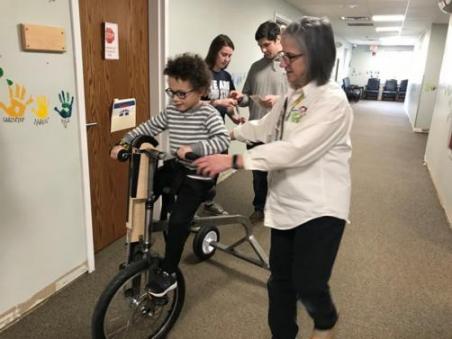
The students, all seniors — Nicole Linke, 21; Cody Mackanick, 23; Michael Ruch, 23; and Andrew Saienni, 23 — came to visit Schreiber after Nicole and Michael had interned over the summer with Arconic, a Lancaster County manufacturer. Arconic has supported Schreiber for several years by donating and sending volunteers. Nicole and Michael joined a group of Arconic employees for a service day at Schreiber that included a tour by Susan Fisher, Schreiber’s volunteer coordinator.
“We have one hand bike, and it’s too small for some of the kids that need it,” Bernie said. “Susan brought them to me, and they said they were looking for a capstone project for their senior year.”
The tour sparked their engineer brains immediately.
“When I saw this old therapy bike they had, I was intrigued,” Nicole said. “I thought that looked like something we could work on.”
The idea they developed with Bernie was to build a bike for kids ages 6-12 that would require the kids to pedal using only their hands. (Watch Zoey Zweizig do a demonstration ride in the video below.)
“We’re always looking for ways to have upper body resistance,” Bernie said. “One of the best ways to build upper body strength is to have them propel themselves through space.”
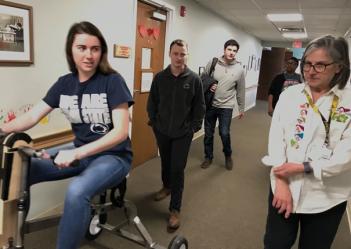
That movement triggers the release of endorphins in the brain that are pleasing and calming at the same time. Bernie saw that immediately when Owen Hull climbed on the bike. Owen is 5, and he receives occupational, physical and speech-language therapy at Schreiber. He’s on the autism spectrum, said his mom Monica Hull.
“If you noticed, the more he rode the more he talked to the college students,” Bernie said. “He engaged with those kids, which he normally doesn’t do. He was mechanically inspecting the bike and asking questions about it. Oh, I got such a charge out of it.”
The students have enjoyed the work, too. They started in September and the bike they brought this week was a first prototype. They will take it back and make adjustments based on the feedback from Bernie, and from the kids. They asked the kids what colors the bike should be, for example. The project should be finished in April and will be exhibited during Penn State Harrisburg’s annual show of capstone engineering projects in May.
None of the students knew anything about Schreiber a year ago. All are from outside of Lancaster County. But they connected right away with Schreiber’s mission and wanted to do something to help.
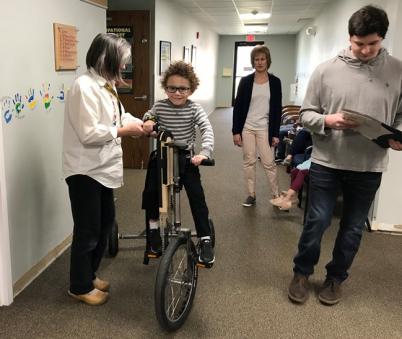
“I just liked spending a year working on something that will help someone instead of making something for a company that might not even use it,” Nicole said.
“Knowing that it would be used every day is really important,” Cody Mackanick added.
The students raised the money for the bike themselves, about $1,500 in all, through a GoFundMe page. They spent a portion of that for the materials to build the bike.
And the rest? That money they will donate that to Schreiber.
Changes bring start of new era
October 25, 2018Some of you probably already know that what we call Schreiber today has been around since 1936. In those 82 years, we have gone by several different names: The Society for Crippled Children and Adults, the National Easter Seals Society and, starting in 1994, Schreiber Pediatric Rehab Center of Lancaster County.
Now, we are excited to tell you about our new name and introduce our new logo.

In the nearly 25 years since we adopted our most recent name, Schreiber has experienced many changes and a lot of growth. We see more children than ever. We see kids with a wider array of diagnoses. We did a major expansion in 2006, and we have added new services, including aquatic therapy, thanks to our new pool, and the Circle of Friends Academy daycare center, which now accepts children as young as 6 weeks.
The staff and the board leadership of the center began to think that our name didn’t reflect the breadth of services we provide. While we still see many kids that you might expect to see at Schreiber, kids born with cerebral palsy or spina bifida, we also see lots of other kids whose challenges aren’t nearly as complex. They might have a minor speech delay or need a little help with their fine motor skills.
We also have a fair number of typically developing kids. They attend our S.T.A.R.S. Preschool or Circle of Friends. Or they come for swim lessons. Or they attend with their parents to learn baby signing or infant massage or kids’ yoga.
As our new mission statement reads: “We provide everything needed for all of life’s challenges, so that families and children can reach their dreams and vision. We see every child’s unique capabilities and help them achieve their fullest potential.”
The new mission statement guided the conversations about finding a new name. After numerous meetings during the strategic planning process of 2017, a stakeholder survey and a final review by the board, we will now be officially known as the Schreiber Center for Pediatric Development.
We didn’t want our brand to send the message that we are fixing “broken” kids. We are helping any family seeking services so that their son or daughter can be their best selves.
And we felt it was important to emphasize our new name with a new logo, one that keeps the name Schreiber at the center of our identity.
So take in our new name: The Schreiber Center for Pediatric Development. Check out our new logo. And know that we will keep doing what we’ve tried to do for 82 years: Enriching lives. Giving hope. For all who need us, every day.
Support Schreiber for the Extra Give
We have a new name and a new logo, but we still rely on the generosity of the community to operate.
Please consider a gift to Schreiber during the Extraordinary Give on Nov. 16. Go to www.extragive.org anytime on Nov. 16, find Schreiber’s listing and donate. It’s that easy. And every dollar supports the children of Schreiber.
